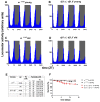Circadian Rhythm Abnormalities in Parkinson's Disease from Humans to Flies and Back
- PMID: 30563246
- PMCID: PMC6321023
- DOI: 10.3390/ijms19123911
Circadian Rhythm Abnormalities in Parkinson's Disease from Humans to Flies and Back
Abstract
Clinical and research studies have suggested a link between Parkinson's disease (PD) and alterations in the circadian clock. Drosophila melanogaster may represent a useful model to study the relationship between the circadian clock and PD. Apart from the conservation of many genes, cellular mechanisms, signaling pathways, and neuronal processes, Drosophila shows an organized central nervous system and well-characterized complex behavioral phenotypes. In fact, Drosophila has been successfully used in the dissection of the circadian system and as a model for neurodegenerative disorders, including PD. Here, we describe the fly circadian and dopaminergic systems and report recent studies which indicate the presence of circadian abnormalities in some fly PD genetic models. We discuss the use of Drosophila to investigate whether, in adults, the disruption of the circadian system might be causative of brain neurodegeneration. We also consider approaches using Drosophila, which might provide new information on the link between PD and the circadian clock. As a corollary, since PD develops its symptomatology over a large part of the organism's lifespan and given the relatively short lifespan of fruit flies, we suggest that genetic models of PD could be used to perform lifelong screens for drug-modulators of general and/or circadian-related PD traits.
Keywords: Drosophila; PD models; Parkison’s disease; circadian clock; dj-1; dopaminergic system.
Conflict of interest statement
The authors declare no conflict of interest.
Figures



Similar articles
-
Drosophila PINK1 and parkin loss-of-function mutants display a range of non-motor Parkinson's disease phenotypes.Neurobiol Dis. 2017 Aug;104:15-23. doi: 10.1016/j.nbd.2017.04.014. Epub 2017 Apr 21. Neurobiol Dis. 2017. PMID: 28435104 Free PMC article.
-
Circadian Rhythms and Sleep in Drosophila melanogaster.Genetics. 2017 Apr;205(4):1373-1397. doi: 10.1534/genetics.115.185157. Genetics. 2017. PMID: 28360128 Free PMC article. Review.
-
Effects of MUL1 and PARKIN on the circadian clock, brain and behaviour in Drosophila Parkinson's disease models.BMC Neurosci. 2019 May 28;20(1):24. doi: 10.1186/s12868-019-0506-8. BMC Neurosci. 2019. PMID: 31138137 Free PMC article.
-
Characterization of a presymptomatic stage in a Drosophila Parkinson's disease model: Unveiling dopaminergic compensatory mechanisms.Biochim Biophys Acta Mol Basis Dis. 2017 Nov;1863(11):2882-2890. doi: 10.1016/j.bbadis.2017.07.013. Epub 2017 Jul 14. Biochim Biophys Acta Mol Basis Dis. 2017. PMID: 28716706
-
Targeting UCH in Drosophila melanogaster as a model for Parkinson's disease.Front Biosci (Landmark Ed). 2020 Jan 1;25(1):159-167. doi: 10.2741/4800. Front Biosci (Landmark Ed). 2020. PMID: 31585883 Review.
Cited by
-
Antioxidant Therapy in Parkinson's Disease: Insights from Drosophila melanogaster.Antioxidants (Basel). 2020 Jan 7;9(1):52. doi: 10.3390/antiox9010052. Antioxidants (Basel). 2020. PMID: 31936094 Free PMC article. Review.
-
BSCL2 and CDK5 are two genes associated with circadian rhythm disturbance in Parkinson's disease.Sci Rep. 2025 Jul 1;15(1):22096. doi: 10.1038/s41598-025-05580-2. Sci Rep. 2025. PMID: 40594234 Free PMC article.
-
Recent Progress in Non-motor Features of Parkinson's Disease with a Focus on Circadian Rhythm Dysregulation.Neurosci Bull. 2021 Jul;37(7):1010-1024. doi: 10.1007/s12264-021-00711-x. Epub 2021 Jun 15. Neurosci Bull. 2021. PMID: 34128188 Free PMC article. Review.
-
Changes in Day/Night Activity in the 6-OHDA-Induced Experimental Model of Parkinson's Disease: Exploring Prodromal Biomarkers.Front Neurosci. 2020 Oct 14;14:590029. doi: 10.3389/fnins.2020.590029. eCollection 2020. Front Neurosci. 2020. PMID: 33154717 Free PMC article.
-
A Computational Analysis in a Cohort of Parkinson's Disease Patients and Clock-Modified Colorectal Cancer Cells Reveals Common Expression Alterations in Clock-Regulated Genes.Cancers (Basel). 2021 Nov 28;13(23):5978. doi: 10.3390/cancers13235978. Cancers (Basel). 2021. PMID: 34885088 Free PMC article.
References
-
- Barone P., Antonini A., Colosimo C., Marconi R., Morgante L., Avarello T.P., Bottacchi E., Cannas A., Ceravolo G., Ceravolo R., et al. The PRIAMO study: A multicenter assessment of nonmotor symptoms and their impact on quality of life in Parkinson’s disease. Mov. Disord. 2009;24:1641–1649. doi: 10.1002/mds.22643. - DOI - PubMed
Publication types
MeSH terms
Substances
Grants and funding
LinkOut - more resources
Full Text Sources
Medical
Molecular Biology Databases
Research Materials

